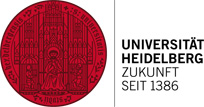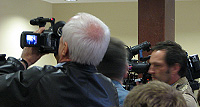How Jacob Gould Schurman Donated a New Auditorium Building to Heidelberg University
Press Release No. 12/2009
9 02 2009
9 02 2009
In the late 1920s the Heidelberg University alumnus and ambassador of the United States in Berlin initiated a fundraising scheme — New University opened in 1931 — Inscription “To the Living Spirit” coined by German Studies scholar Friedrich Gundolf
Heidelberg University has always been generously supported by friends and donors. Notably in Old Town Heidelberg there are numerous architectural testimonies to the generosity of these benefactors. Two remarkable buildings — Haus Buhl and the Villa Poensgen — still bear the names of their previous owners, who bequeathed these properties to the University. But probably the most spectacular donation of this kind in the 20th century is the New University auditorium building, which was erected in 1930/1931 to replace the former “Kollegienhaus” on University Square.
At a dinner of the Steuben Society in New York in early 1928, the American ambassador to Germany, Jacob Gould Schurman, announced that he had initiated a 400,000-dollar fundraising campaign to finance an urgently needed auditorium building for Heidelberg University. This sensational news spread like wildfire in the German capital. Shortly afterwards, the then Rector of Heidelberg University, theologian Martin Dibelius, was informed of the campaign and was naturally highly gratified. In May of the same year, Schurman and the German foreign minister Gustav Stresemann were awarded honorary doctorates by the Faculty of Philosophy. In December they were made honorary citizens of Heidelberg. On this occasion, Schurman disclosed the results of his fundraising campaign. It had amassed over 500,000 dollars donated by wealthy Americans, including such successful entrepreneurs as Walter P. Chrysler and John D. Rockefeller.
Who was Jacob Gould Schurman? Born in 1854 on Prince Edward Island, Canada, he grew up in modest circumstances and developed into an ambitious and successful student who was awarded numerous prizes and scholarships. One of these took him to Europe and in 1878/79 he ended up in Heidelberg. The sojourn left an indelible impression on him. Later Schurman declared that it was here that his lifelong interest in German cultural and intellectual history was first awakened, an enrichment for which he remained eternally grateful. Subsequently he embarked on a career in higher education and for a time was President of Cornell University. He was also active as a politician, holding various offices including that of ambassador to Germany from 1925 to 1930.
Heidelberg expert on America, Prof. Dr. Detlef Junker, has taken a profound interest in Schurman. For him, the motivation for the fundraising campaign derives from the tradition of “Protestant austerity” and its insistence that personal wealth should be used to support society, which otherwise would degenerate into a “herd of animals.” “In Schurman’s view a rich man should be obligated by his conscience to employ, if not donate, the resources entrusted to him (by God) for morally unimpeachable purposes,” writes Junker. “To a substantial degree Heidelberg owes its New University to this spirit, the original principle underlying the many American foundations established prior to the invention of tax-deductible donations.”
The construction work on the building began in 1930. Planning was entrusted to architect Karl Gruber of Danzig (now Gdansk), who opted for what he called “contemporary, uncluttered architecture without modernist leanings.” The inscription “To the Living Spirit” over the front entrance was coined by German Studies scholar Friedrich Gundolf, winning out over the other “dedications” that had been proposed. But the opening ceremony for the main building and the western annexe in 1931 was overshadowed by adumbrations of a sinister new zeitgeist. Though Jacob Gould Schurman was spared any personal offense, students of a National Socialist persuasion gave free rein to their anti-American and anti-Semitist attitudes with demonstrations and stink-bombs. The festivities themselves were notable for an unprecedented feat of technical ingenuity, the first direct link-up with the USA in the history of German telecommunications. Alongside Schurman and the English Studies scholar Hoops, two students also made speeches on this occasion, one American, the other a German girl. Schurman was greatly taken by what she had to say. “The few, short, straightforward sentences pronounced by this young student were immediately understood in America,” he enthused. “This is the way to speak to the people over there if you really want to make contact with them.”
But in the aftermath, the amicable German-American relations conjured in Schurman’s response were gradually eroded by the political and social developments in Germany. Jacob Gould Schurman died in 1942, but he was presumably informed of the replacement of the sculpture of Pallas Athena and the inscription “To the Living Spirit” by an imperial eagle and the new dedication “To the German Spirit”. He may also have heard that in 1938 his bronze bust and the plaque bearing the names of the donors in the interior of the building had to make way for a bust of Adolf Hitler.
After the end of the Second World War, the Gundolf inscription and the Pallas Athena sculpture were reinstated. And in 1961 a commemorative plaque for Jacob Gould Schurman was unveiled outside the Great Hall of the New University. Today, the memory of this committed and generous sponsor seems more vivid than ever before. A library, a scholarship and a series of lectures all bear his name. Indeed, there appears to be a general quickening of interest in Heidelberg University on the part of donors, benefactors and sponsors, some of them displaying their commitment with large-scale projects. Jacob Gould Schurman will always be an inspiration to them all.
Contacts
Dr. Tanja Fichtner
Marketing & Strategy
Dezernat für Beziehungspflege — Stiftungen — Vermögen
Heidelberg University
Seminarstr. 2
D-69117 Heidelberg
phone: +49 6221 542135
fax: +49 6221 543666
mobile: +49 173 6737668
e-mail: tanja.fichtner@zuv.uni-heidelberg.de
General inquiries from journalists should also be addressed to
Dr. Michael Schwarz
Public Information Officer
Heidelberg University
Grabengasse 1
D-69117 Heidelberg
phone: +49 6221 542310
fax: +49 6221 542317
michael.schwarz@rektorat.uni-heidelberg.de
http://www.uni-heidelberg.de/presse
Irene Thewalt
phone: +49 6221 542310
fax: +49 6221 542317
e-mail: presse@rektorat.uni-heidelberg.de
At a dinner of the Steuben Society in New York in early 1928, the American ambassador to Germany, Jacob Gould Schurman, announced that he had initiated a 400,000-dollar fundraising campaign to finance an urgently needed auditorium building for Heidelberg University. This sensational news spread like wildfire in the German capital. Shortly afterwards, the then Rector of Heidelberg University, theologian Martin Dibelius, was informed of the campaign and was naturally highly gratified. In May of the same year, Schurman and the German foreign minister Gustav Stresemann were awarded honorary doctorates by the Faculty of Philosophy. In December they were made honorary citizens of Heidelberg. On this occasion, Schurman disclosed the results of his fundraising campaign. It had amassed over 500,000 dollars donated by wealthy Americans, including such successful entrepreneurs as Walter P. Chrysler and John D. Rockefeller.
Who was Jacob Gould Schurman? Born in 1854 on Prince Edward Island, Canada, he grew up in modest circumstances and developed into an ambitious and successful student who was awarded numerous prizes and scholarships. One of these took him to Europe and in 1878/79 he ended up in Heidelberg. The sojourn left an indelible impression on him. Later Schurman declared that it was here that his lifelong interest in German cultural and intellectual history was first awakened, an enrichment for which he remained eternally grateful. Subsequently he embarked on a career in higher education and for a time was President of Cornell University. He was also active as a politician, holding various offices including that of ambassador to Germany from 1925 to 1930.
Heidelberg expert on America, Prof. Dr. Detlef Junker, has taken a profound interest in Schurman. For him, the motivation for the fundraising campaign derives from the tradition of “Protestant austerity” and its insistence that personal wealth should be used to support society, which otherwise would degenerate into a “herd of animals.” “In Schurman’s view a rich man should be obligated by his conscience to employ, if not donate, the resources entrusted to him (by God) for morally unimpeachable purposes,” writes Junker. “To a substantial degree Heidelberg owes its New University to this spirit, the original principle underlying the many American foundations established prior to the invention of tax-deductible donations.”
The construction work on the building began in 1930. Planning was entrusted to architect Karl Gruber of Danzig (now Gdansk), who opted for what he called “contemporary, uncluttered architecture without modernist leanings.” The inscription “To the Living Spirit” over the front entrance was coined by German Studies scholar Friedrich Gundolf, winning out over the other “dedications” that had been proposed. But the opening ceremony for the main building and the western annexe in 1931 was overshadowed by adumbrations of a sinister new zeitgeist. Though Jacob Gould Schurman was spared any personal offense, students of a National Socialist persuasion gave free rein to their anti-American and anti-Semitist attitudes with demonstrations and stink-bombs. The festivities themselves were notable for an unprecedented feat of technical ingenuity, the first direct link-up with the USA in the history of German telecommunications. Alongside Schurman and the English Studies scholar Hoops, two students also made speeches on this occasion, one American, the other a German girl. Schurman was greatly taken by what she had to say. “The few, short, straightforward sentences pronounced by this young student were immediately understood in America,” he enthused. “This is the way to speak to the people over there if you really want to make contact with them.”
But in the aftermath, the amicable German-American relations conjured in Schurman’s response were gradually eroded by the political and social developments in Germany. Jacob Gould Schurman died in 1942, but he was presumably informed of the replacement of the sculpture of Pallas Athena and the inscription “To the Living Spirit” by an imperial eagle and the new dedication “To the German Spirit”. He may also have heard that in 1938 his bronze bust and the plaque bearing the names of the donors in the interior of the building had to make way for a bust of Adolf Hitler.
After the end of the Second World War, the Gundolf inscription and the Pallas Athena sculpture were reinstated. And in 1961 a commemorative plaque for Jacob Gould Schurman was unveiled outside the Great Hall of the New University. Today, the memory of this committed and generous sponsor seems more vivid than ever before. A library, a scholarship and a series of lectures all bear his name. Indeed, there appears to be a general quickening of interest in Heidelberg University on the part of donors, benefactors and sponsors, some of them displaying their commitment with large-scale projects. Jacob Gould Schurman will always be an inspiration to them all.
From Unispiegel, special edition, spring 2006, pp. 6/7 (expanded)
http://www.to-the-living-spirit.comContacts
Dr. Tanja Fichtner
Marketing & Strategy
Dezernat für Beziehungspflege — Stiftungen — Vermögen
Heidelberg University
Seminarstr. 2
D-69117 Heidelberg
phone: +49 6221 542135
fax: +49 6221 543666
mobile: +49 173 6737668
e-mail: tanja.fichtner@zuv.uni-heidelberg.de
General inquiries from journalists should also be addressed to
Dr. Michael Schwarz
Public Information Officer
Heidelberg University
Grabengasse 1
D-69117 Heidelberg
phone: +49 6221 542310
fax: +49 6221 542317
michael.schwarz@rektorat.uni-heidelberg.de
http://www.uni-heidelberg.de/presse
Irene Thewalt
phone: +49 6221 542310
fax: +49 6221 542317
e-mail: presse@rektorat.uni-heidelberg.de
Editor:
Email

